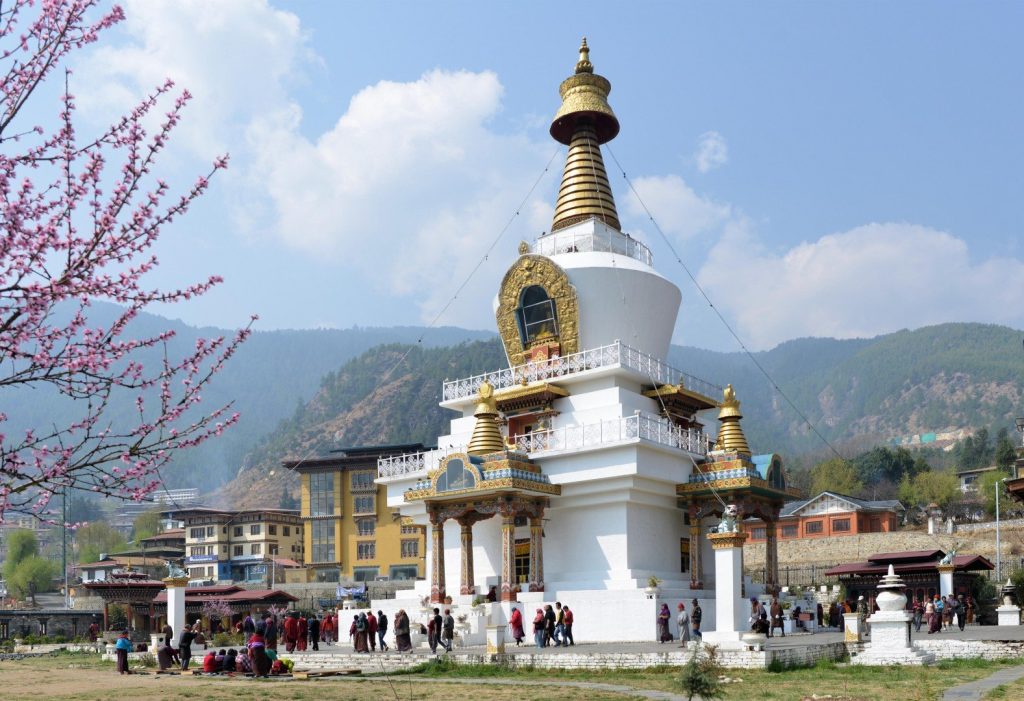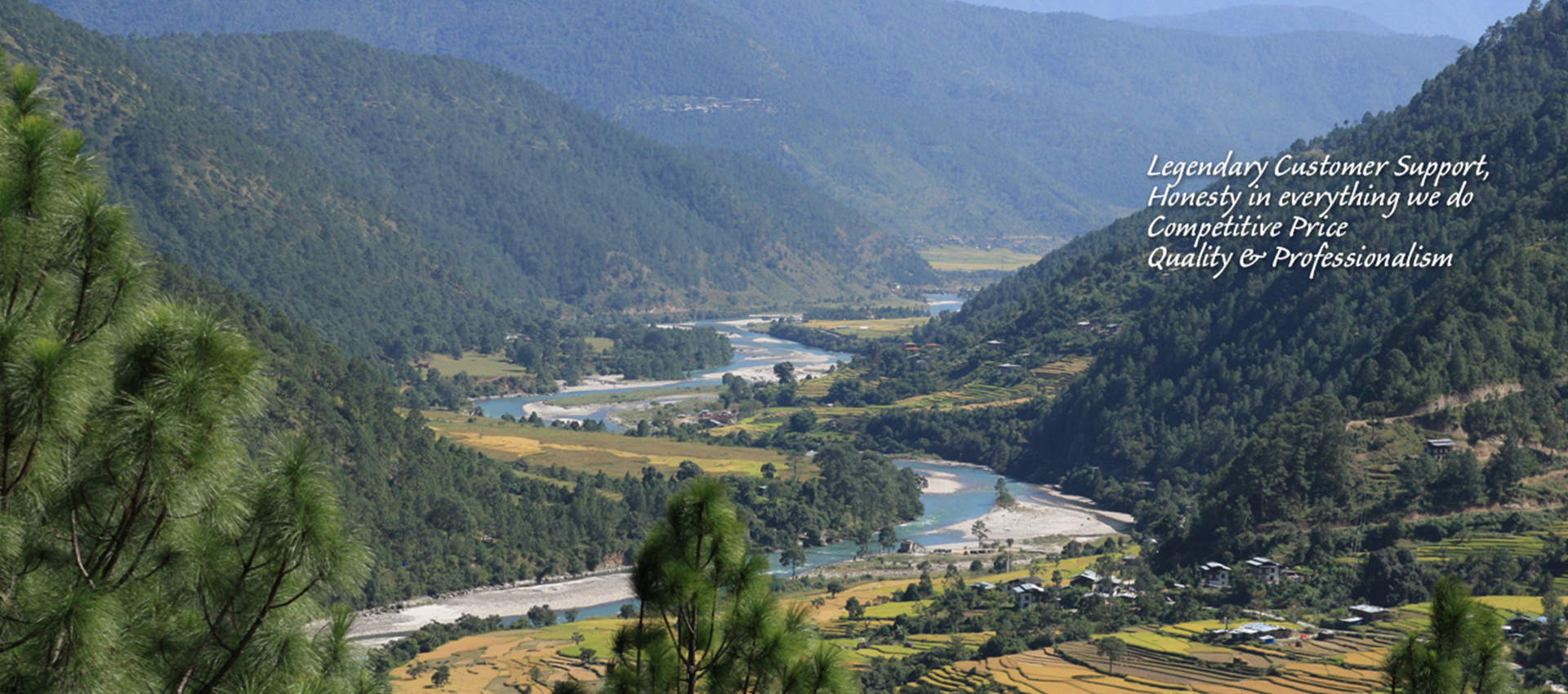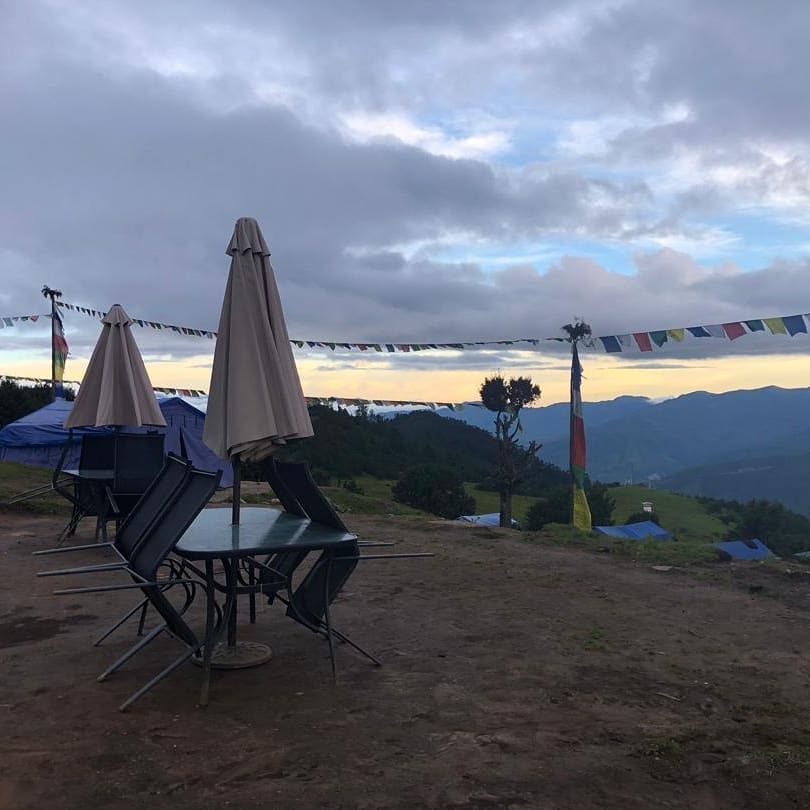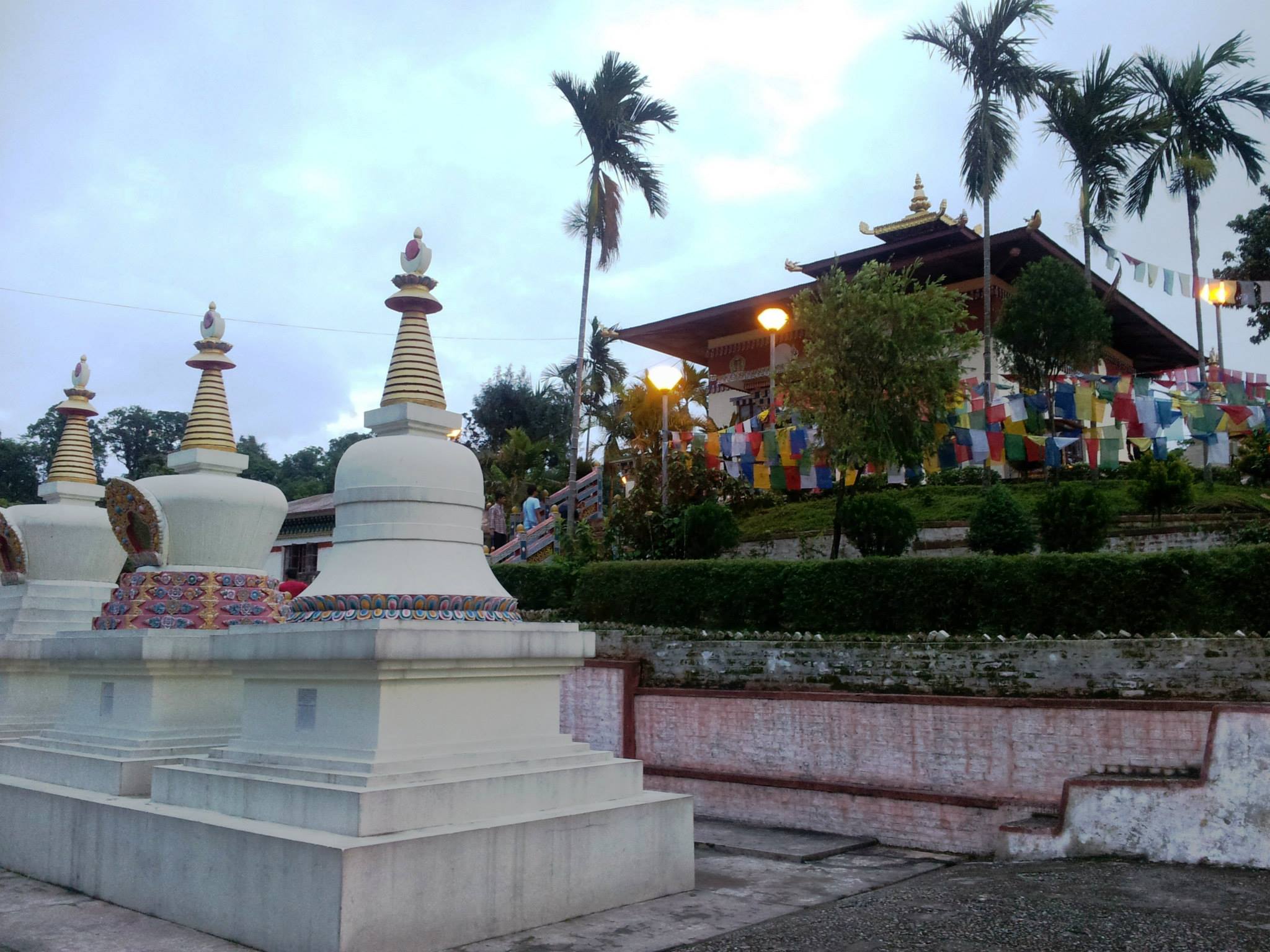Our “Introduction to Bhutan” itinerary spans the length of the country, covering numerous sites of historical and natural interest. This journey provides a great introduction to Western, Central, and Southern Bhutan. Beyond all the stunning sights and attractions it has to offer, you will have an opportunity to hike along the ridge in Dochula, enjoying panoramic views of the Northern Himalayan peaks, and time to relax in the Glacier Valley of Gangtey.
Trip Highlights
- Hike to Taktsang.
- Visit traditional unspoilt villages.
- Explore Historic fortress in Thimphu & Punakha.
- Walk in National Park in Gangtey.
- Visit unique village in Wangdue & Phobjikha Valley.
Day 01: Arrival in Phuentsholing
Upon arrival in Bagdogra, meet our representative and drive to the frontier town of Phuentsholing. After clearing immigration formalities, check in at the hotel. Phuentsholing is a flourishing commercial center situated in the foothills. Being a border town, Phuentsholing serves as a convenient entry/exit point for Bhutan and an important link to visit the Indian states of West Bengal, Sikkim, Darjeeling, and Assam. In the latter half of the day, visit Zangtopelri Lhakhang, located in the heart of the town. This site is dedicated to Guru Rinpoche, with eight manifestations of the Guru portrayed on the ground floor. The second floor contains statues of eight Bodhisattvas, Avalokiteshvara, and Zhabdrung Ngawang Namgyal, while the top floor houses the main statue of Buddha Amitabha.
Overnight at the hotel in Phuentsholing (Altitude 300m).
Day 02: Phuentsholing – Thimphu (155 km, approx.4 -hour drive)
In the morning, after breakfast, we drive to Thimphu. On the way, visit Kharbandi Goemba, a 20-minute drive from Phuentsholing town on the Phuentsholing-Thimphu highway. Founded by Royal Grandmother Ashi Phuntsho Choedon in 1967, the monastery features beautiful illustrations of Buddha on its walls, with statues of Guru Rinpoche and Zhabdrung Ngawang Namgyal. It offers a magnificent view of the Indian plains and Phuentsholing town from its lawn.
In Thimphu, visit Buddha Dordenma, one of the largest statues of Shakyamuni at a height of 51.5 meters. Cast in bronze and gilded with gold, it overlooks the southern gate of the valley. Inside, 125,000 miniature statues are placed. The statue features a large prayer hall with Buddha seated upon it.
The National Memorial Chorten was constructed to dedicate world peace and in loving memory of the third King, Jigme Dorji Wangchuck, “the father of modern Bhutan.” This landmark is an iconic monument where you can see a large crowd of people circumambulating and chanting mantras.
Later in the evening, take a leisurely walk around the clock tower and Thimphu’s main street.
Overnight at the hotel in Thimphu (Altitude 2,320m).

Day 03: Thimphu
After breakfast, we have a full day to visit Thimphu local sights. Begin the day from visit to Thangthong Dewachen Nunnery, locally known as Zilukha Nunnery, is one of the largest nunneries in Bhutan. Built by Thangtong Gyelpo, the builder of iron chain bridges across Bhutan and Tibet, it features an interesting enclosed chorten in the main courtyard.
The Takin Sanctuary is home to the national animal of Bhutan, the Takin, which resembles a goat and a yak and is found in high mountainous terrain. Legend has it that the Tibetan saint, Drukpa Kunley, known as the “Divine Madman,” created this unique animal.
The Textile Museum in Chubachu houses a cultural and heritage collection of antique textile artifacts. Different patterns from authentic Bhutanese weavers from various parts of the country are exhibited.
The National Institute for Zorig Chusum and Choki Art Institute is a training center for cultural and traditional arts and crafts. Here, students are trained in 13 different techniques for six years in traditional painting, woodcarving, and statue making.
In the latter half of the day, visit Simtokha Dzong, built by Zhabdrung Ngawang Namgyal in 1629. It literally means “Atop a Demon.” The dzong is a replica of the Gyal Gyad Tshel Institute of Ralung (Tibet) and is perhaps the first dzong built in Bhutan, making it the oldest.
The Centenary Market in Thimphu, located beside the Wangchu River, commemorates the coronation of the fifth King. It is also the largest domestic weekend market for the sale of vegetables, fruits, meats, and farm products. Farmers from different parts of the country come here to sell their produce. A wooden cantilever bridge leads to stalls selling a collection of textiles, handicraft products, and clothing.
Jungshi Paper Factory is a small establishment manufacturing traditional Bhutanese handmade paper made from Daphne bark, known as Deh-sho. You can observe the entire process from the dyeing and sorting of pulps. Greeting cards and other products are available for purchase as souvenirs.
The Craft Market, built with bamboo to preserve an eco-friendly environment, offers hand-woven textiles, Thangkha paintings, masks, ceramics, slate and wood carvings, jewelry, and interesting items made from local materials.
Changangkha Lhakhang, located on a small hilltop overlooking the Thimphu valley below Motithang, features Chenrigzi with an 11-head and thousand-arms manifestation. Most Bhutanese visit this temple to seek blessings for a new child.
The National Library contains a collection of religious texts on Bhutan’s history, religious scriptures, traditional medical books, arts, and culturally integrated documentation.
Changlimithang Stadium is the national stadium of Bhutan, where you can glimpse an archery match and where national football tournaments are held.
The Folk Heritage Museum offers insight into an impressive collection of artifacts from rural households and the traditional Bhutanese way of life.
Tashichho Dzong is a towering fortress, nestled beside the Thimphu Chu, is a magnificent example of Bhutanese architecture. It houses the seat of the Chief Abbot, the throne room, and offices of the King, the Cabinet Secretariat, and the Ministries of Home Affairs and Finance. Originally built in 1216 and rebuilt in 1641 by the political and religious unifier of Bhutan, Shabdrung Ngawang Namgyal, it was reconstructed in the 1960s in the traditional Bhutanese manner, without nails or architectural plans.
Overnight at the hotel in Thimphu (Altitude 2,320 m).
Day 04: Thimphu – Gangtey (150km, approx. 5-hour drive)
In the morning, after breakfast, we drive to Gangtey. We climb up to Dochu-La Pass (3,086m). Dochula Pass is a popular destination for tourists and locals alike. The 108 stupas were constructed by the eldest Queen Mother, Ashi Dorji Wangmo Wangchuk. The pass has three layers: the top layer has twenty-seven stupas, the middle one thirty-six, and the lower one forty-five, known as Druk Wangyal Chortens. On a clear day, you can enjoy a clear view of the northern Himalayas from the pass, including Masagang (7,158m), Tsendagang (6,960m), and Gangkar Puensum, the highest peak in Bhutan at 7,570m.
Druk Wangyal Lhakhang (temple), built in honor of His Majesty the fourth Druk Gyalpo, Jigme Singye Wangchuck, presents a fusion of the past and future in its details. The structure tells the story of a supreme warrior figure whose vision pierces the distant future, blending history and mythology.
Rinchengang Village, near Wangdue Phodrang and opposite Wangdue Phodrang Dzong, is clustered with traditional Bhutanese houses. Legend has it that the village was constructed for artisans when Wangdue Phodrang Dzong was under construction. Wangdue Phodrang Dzong, founded by Zhabdrung Ngawang Namgyal in 1638 on a high ridge between Punakha and Trongsa, caught fire on 24 June 2012 and was virtually destroyed, save for the lower walls. Under the command of His Majesty the King, reconstruction of the dzong began in January 2014, and it has since been restored to its original form.
Phobjikha is a glacial valley that lies on the western slopes of the Black Mountains, popularly known as Gangtey Valley due to the enchanting monastery perched on a hilltop bordering the Jigme Singye Wangchuck National Park. Large flocks of black-necked cranes migrate here during the winters from Tibet circling 3 time around the Monastery and repeats the same while returning to Tibet.
Overnight at the hotel in Gangtey. (Altitude 3,000m)
Day 05: Gangtey – Punakha & Wangdue (87km, approx. 3-hour drive)
After breakfast, take a short drive to visit the Black Necked Crane Center. This center is a haven for Black Necked Cranes, which migrate from the Tibetan Plateau to the Phobjikha Valley during winters, from October to March. It features an observation room for a closer look at the cranes. The Gangtey Monastery, situated on a small hill rising from the valley floor, is the largest Nyingmapa monastery in Bhutan. It has a lineage tracing back to Pema Lingpa, the renowned Nyingmapa saint of Bhutan. Surrounding it is a small village where the annual Black Necked Crane festival is held in the courtyard to welcome the cranes migrating from Tibet. We then continue our drive to Punakha.
In Punakha, visit Punakha Dzong, also known as the Palace of Happiness. Located at the confluence of the Pho Chu and Mo Chu rivers, it was built by Zhabdrung Ngawang Namgyal between 1637 and 1638. It is one of the most revered examples of Bhutanese architecture and the most magnificent dzong in Bhutan, being the second-largest in the country. The chief abbot and the monastic body migrate here during the winter season from Thimphu.
The Suspension Bridge, Bhutan’s longest bridge, was built to connect nearby villages. It is 25 meters long, adorned with prayer flags, and offers a breathtaking view of the Punakha Dzong with the glistening Pho Chu river beneath.
Chimi Lhakhang is located in Lobesa on a round hill, blessed by Lama Drukpa Kinley, also known as the Divine Madman, renowned for his crazy wisdom and unorthodox ways of teaching Buddhism. A short hike from the main highway, about half an hour, leads to the temple. Childless women often visit the temple to seek fertility blessings, involving a wooden phallus symbol.
Overnight at the hotel in Punakha (Altitude 1,300m).
Day 06: Punakha & Wangdue – Paro (125 kms, approx. 4.1/2-hour drive)
After breakfast, we drive north of the valley to hike up to Khamsum Yulley Namgyal Chorten, which lies at the northern end of the valley. The hike takes about 45 minutes from the road to the chorten. Constructed by the Queen Mother of Bhutan to remove negative forces and promote peace, stability, and harmony, it offers a picturesque view of the upper Punakha valley from the third floor. We then drive back to Paro, descending from Dochu La and following the dramatic Wang Chhu and Paro Chhu river valleys. Along the way, we visit Tachog Lhakhang, renowned for its 600-year-old iron bridge; beside the bridge, the temple is a highlight for visitors.
Later in the day, we proceed to visit Ta Dzong, originally built as a watchtower and converted into a museum in 1968. Its collection includes fine arts, paintings, textiles, jewelry, handicrafts, stamps, and galleries of stuffed animals and butterflies from Bhutan. The top floor of the museum houses a chapel with a “tree” depicting the main figures of the four religious schools of Tibetan Buddhism.
We then descend to visit Rinpung Dzong, constructed in 1644 and known as the “fortress of the heap of jewels.” The courtyard features fine Bhutanese paintings depicting the life of Buddha, cosmic mandalas, and the narrative of Milarepa. The most famous Paro festival is held here, with the unfurling of a giant thangka on the last day.
Next, we walk down the trail through a wooden cantilever bridge to Paro town, where you may observe an archery tournament, Bhutan’s national game. Dungtse Lhakhang, a small chorten beside Paro Town across the Paro Chu, was built by Thangtong Gyelpo in 1421 to subdue an ogress. The temple’s unique paintings depict the progressive stages of Tantric Buddhist philosophy, as well as the most significant deities and figures of the Drukpa Kagyu school.
Later in the afternoon, we drive to the north end of the valley to visit Drukgyel Dzong. It was in ruins until 2000 but has since been reconstructed to its original form. Zhabdrung Ngawang Namgyal built it in 1646 to commemorate the victory over Tibetan invaders. Kyichu Lhakhang, one of the oldest temples, was constructed by King Songtsen Gampo of Tibet in the 7th century. Of the 108 temples built during his reign, Kyichu is among the 12 main temples. Located 5 km from Paro town, it houses the original 7th-century Jowo Jampa Statue, along with eight standing bodhisattvas and statues of Zhabdrung, Guru Rinpoche, and Chenrezig with 11 heads and 1000 arms.
In the evening, explore the local market and town of Paro.
Overnight at the hotel in Paro. (Altitude 2,280m)
Day 07: In Paro
After breakfast, we drive to the trailhead to hike up to Taktshang Monastery (approximately a 5-hour round-trip walk). It is one of the most important monasteries in Bhutan, perched on the side of a cliff 900m above the Paro valley floor. It is said that Guru Rinpoche arrived here on the back of a tigress and meditated at this monastery, hence it is called ‘Tiger’s Nest’. This site has been recognized as a most sacred place and was visited by Zhabdrung Ngawang Namgyal in 1646. It is now a place visited by all Bhutanese at least once in their lifetime.
Spend the evening at leisure in the charming town of Paro.
Optional tour: Chelela Pass
After breakfast, embark on an optional tour to Chele La Pass. At an elevation of 3,988 meters, it is considered one of the highest motorable passes in Bhutan, connecting Paro and Haa Valley. The pass is marked by hundreds of prayer flags fluttering in the wind. From here, you can enjoy spectacular views of Mt. Jomolhari and Mt. Jichu Drake. Upon returning from Chele La Pass, take a short drive to visit Dzongdrakha Lhakhang, often renowned as the smaller replica of Taktsang Monastery. It is believed that Guru Rinpoche first landed here upon his arrival in Bhutan. During the annual festival at Dzongdrakha, the chorten of the past Buddha is opened, allowing visitors to receive blessings from the relic kept there. Later, visit the Bonday village with a mild walk, exploring traditional farmhouses and meeting local people. Spend the evening at leisure in the charming town of Paro.
Overnight at the hotel in Paro. (Altitude 2,280m)
Day 08: Paro – Phuentsholing (150 km, approx. 4.1/2-hour drive)
Overnight at the hotel in Phuentsholing. (Altitude 300m)
Day 9: Departure: Exit to India
After breakfast, depart from Phuentsholing for your onward journey to Bagdogra.










